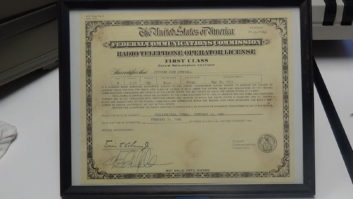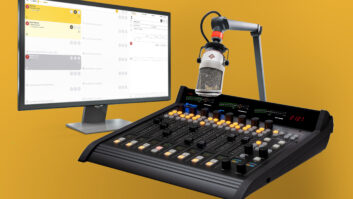In a time when more and more companies are introducing IP audio codecs, VoIP codecs and large multiline talk show systems, it is good to know that there is still a need for a simple POTS hybrid. The Telos Hx1 hybrid packs sophisticated digital controls into an enhancement designed for POTS lines for broadcast.
Once racked the Telos Hx1 looks polished and sleek. Its simple design and minimalistic display do little to allude to the powerful processing going on inside.
The front-panel meters are an upgrade rarely seen on a telephone hybrid. The tricolor LED meters are bright and easy to read from a distance, displaying levels from –36 to 20 dBu. Included alongside the “SND” and “RCV” meters are low and high EQ meters, which show the amount of gain adjustment that is being applied to the incoming caller’s audio in the respective frequency bands.

Rounding out the front are three pushbutton switches and corresponding line status display. The line status displays Telos’ proprietary Status Symbol visual call management icons to show line and caller status. Users familiar with these icons will be right at home.
Looks
Unfortunately the clarity of the Status Symbol readout wasn’t up to par compared to the sleek meters. Users need to view the recessed Status Symbol screen head-on, as the LED has poor off-axis visibility. To best accommodate all hybrid users, a crossbreed status display that includes both a Status Symbol and text-based readout on a small LCD screen would have improved the user interface greatly.
The rear panel of the Hx1 is nearly as clean and minimalistic as the front. There is a mic/line pushbutton selector, and input level adjustment knob. “Send In” and “RCV Out” connections are made via XLR connectors and phone and line RJ-11 jacks appear for the POTS connections. There is a nine-pin D-sub for remote (GPIO) control including “line ringing” and “hybrid in use” indications. “Setting” and “Options” are made using two banks of DIP switches, and a standard power connection.

For testing purposes, the Hx1 was set up in the master control/TOC and connected to the studio via a combination of fiber and Cat-5 connections. The console was digital and included mix-minus capability. All sample recordings were made using a DAW with no additional audio processing or gain. The phone line feeding the hybrid was POTS passed through a Cisco VG248 for extension mobility. Out of the box, only the auto-answer configuration setting was programmed via the DIP switches, since the hybrid was located in the TOC not the studio.
The first testing scenario was to make a series of mobile phone calls. All numbers were U.S.-based, and on various cellular networks. The factory default settings were used except in the case of auto answer. The factory defaults are set to use adaptive EQ, 0 dB EQ adjustments (high and low), –6 dB attenuation ducker processing, phone AGC full, noise gate off, no additional gain to caller, internal mix-minus disabled and AGC disabled.
I was underwhelmed with these initial settings in the cell phone audio calls. There were distinct DSP processing artifacts likely caused by the adaptive EQ coupled with an overly aggressive attack of the automatic gain control function. However, despite the digital artifact distraction, users will appreciate a bright, intelligible audio quality. As compared to existing digital hybrids, this enhancement was immediately noticeable. Likewise, the caller also reported better-than-average return program audio clarity.
The second test scenario set out to correct the default settings to best adapt them for my system. Using the same mobile phone for every test call, the dynamic digital equalization (DDEQ) configuration settings were varied according to the DIP switch guide. As recommended by Telos, I utilized a full 6 dB boost in both the “EQ LO” and “EQ HI” configuration settings and then set out to compare varying degrees of DDEQ processing functions.
Testing
PRODUCT CAPSULE Telos Hx1 Hybrid Telephone Interface
Thumbs Up
• AGC to smooth output levels, reduce gating effects
• Fixed or adaptive EQ with separate EQ level adjustments
• Full-color front-panel meters
• Mobile calls are consistently high-quality audio
• Good value
Thumbs Down
• Status Symbol readout display difficult to read
• Needs network connectable/Web interface
Price: $795 list
For information, contact Telos Systems in Ohio at (216) 920-1813 or visit www.telos-systems.com. As in the previous test, both the adaptive EQ mode and the adaptive plus fixed EQ settings produced similar and noticeable digital vocal processing artifacts. The effect was similar to vocal pitch shifters combined with heavy compression, as the adaptive EQ struggled to keep up with the higher frequency content of the caller audio. The fixed EQ mode coupled with the +6 dB EQ “HI/LO” produced the best sound. The speech was warm, crisp and completely natural, with no noticeable compression nor frequency shifting artifacts. As the fixed EQ adjustments reduced to zero (+4 dB, +2 dB, 0 dB), the obvious effects of flattened response are noticed, but did not adversely affect the quality of the caller audio.
Further tweaking the setting to adjust for AGC, the fixed EQ +6 dB was tested using no AGC, half engaged and fully engaged. Here the factory default performed the best on the mobile connection. The half engaged didn’t normalize enough and removing AGC produced an even more disparate signal level. The fully engaged AGC appropriately leveled the signals up to the nominal +4 dB level without adding noticeable compression artifacts (AGC appeared to respond differently when the adaptive EQ was disabled). The AGC leveling was smooth, and very adaptive, even when caller audio with high dynamic content was introduced.
Further testing, to include land line phones, produced very favorable results. Having fewer EQ and level issues than the mobile calls, the Hx1 passed the analog phone signals brilliantly. In this instance, the adaptive plus fixed EQ (+6 dB “HI/LO”) worked quite nicely, with the AGC at 1/2 full or full. The ducking function (–6 dB attenuation) was smooth and natural, and provided a much appreciated hands-free approach to mixing the broadcaster and caller audio.
Overall the Telos Hx1 hybrid is rich in features. Users will be pleased with the amount of individual control that the Hx1 provides. There was only one feature users might miss having. In a market where a substantial amount of broadcast equipment is networkable and Web-accessible, the Hx1 doesn’t have a network-controllable GUI. Although there are far fewer settings to manually configure than the more feature-packed (higher end) codecs, it was still a bit burdensome to flip DIP switches between tests. Once racked, it becomes even more trouble to make these setting changes. With the nature of the varying types of calls (domestic land line and mobile, international land and mobile), there is often a need to tweak EQ, and AGC and noise gate. Here a Web-based GUI would save significant time and hassle. Also monitoring the call connection and levels via remote Web GUI is always a welcome feature for a busy engineer.
On the whole the Hx1 delivers a great-sounding hybrid call with just a bit of tweaking out of the box. The Hx1 is feature rich, and adaptable to likely every studio situation. This product really shines on mobile calls, which until now were just best avoided on POTS hybrids.
Laura Mir, CBNT, has been a radio broadcast engineer for more than 10 years. She is a board member of SBE Chapter 37.












